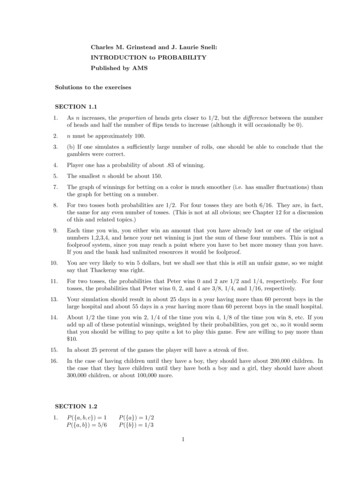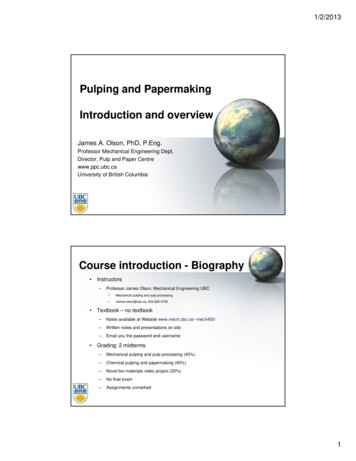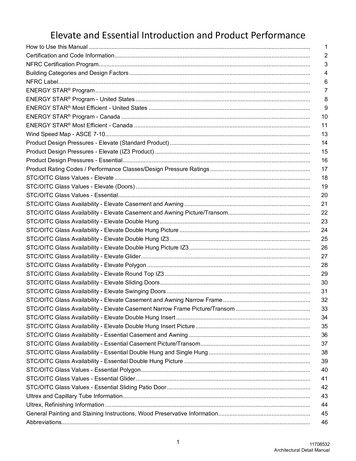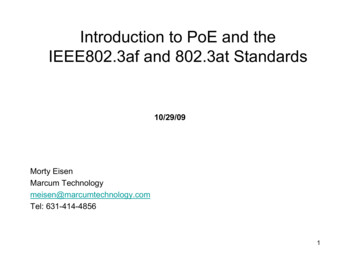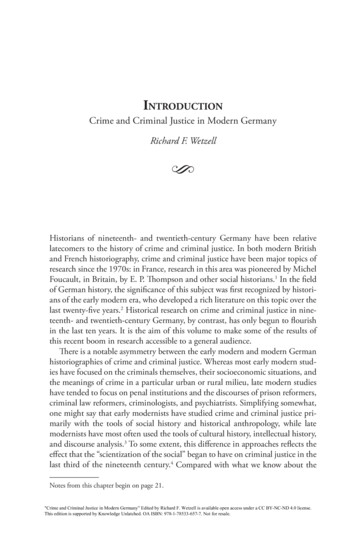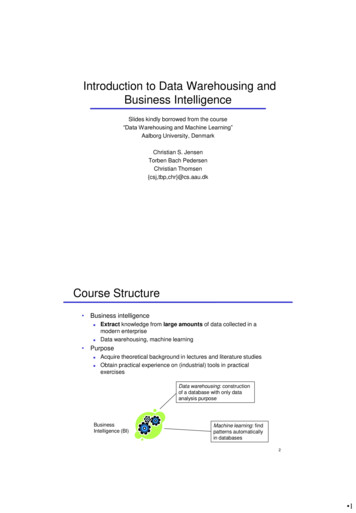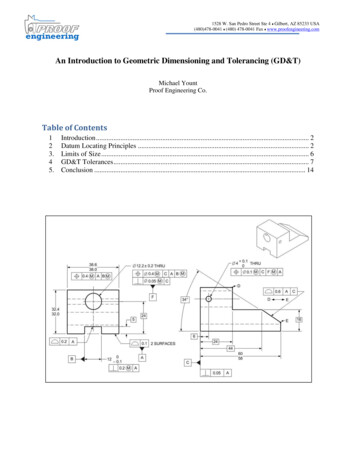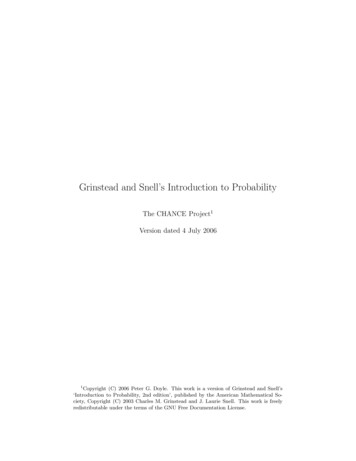
Transcription
Grinstead and Snell’s Introduction to ProbabilityThe CHANCE Project1Version dated 4 July 20061Copyright (C) 2006 Peter G. Doyle. This work is a version of Grinstead and Snell’s‘Introduction to Probability, 2nd edition’, published by the American Mathematical Society, Copyright (C) 2003 Charles M. Grinstead and J. Laurie Snell. This work is freelyredistributable under the terms of the GNU Free Documentation License.
To our wivesand in memory ofReese T. Prosser
ContentsPrefacevii1 Discrete Probability Distributions1.1 Simulation of Discrete Probabilities . . . . . . . . . . . . . . . . . . .1.2 Discrete Probability Distributions . . . . . . . . . . . . . . . . . . . .11182 Continuous Probability Densities2.1 Simulation of Continuous Probabilities . . . . . . . . . . . . . . . . .2.2 Continuous Density Functions . . . . . . . . . . . . . . . . . . . . . .4141553 Combinatorics753.1 Permutations . . . . . . . . . . . . . . . . . . . . . . . . . . . . . . . 753.2 Combinations . . . . . . . . . . . . . . . . . . . . . . . . . . . . . . . 923.3 Card Shuffling . . . . . . . . . . . . . . . . . . . . . . . . . . . . . . . 1204 Conditional Probability4.1 Discrete Conditional Probability . . . . . . . . . . . . . . . . . . . .4.2 Continuous Conditional Probability . . . . . . . . . . . . . . . . . . .4.3 Paradoxes . . . . . . . . . . . . . . . . . . . . . . . . . . . . . . . . .1331331621755 Distributions and Densities1835.1 Important Distributions . . . . . . . . . . . . . . . . . . . . . . . . . 1835.2 Important Densities . . . . . . . . . . . . . . . . . . . . . . . . . . . 2056 Expected Value and Variance2256.1 Expected Value . . . . . . . . . . . . . . . . . . . . . . . . . . . . . . 2256.2 Variance of Discrete Random Variables . . . . . . . . . . . . . . . . . 2576.3 Continuous Random Variables . . . . . . . . . . . . . . . . . . . . . . 2687 Sums of Random Variables2857.1 Sums of Discrete Random Variables . . . . . . . . . . . . . . . . . . 2857.2 Sums of Continuous Random Variables . . . . . . . . . . . . . . . . . 2918 Law of Large Numbers3058.1 Discrete Random Variables . . . . . . . . . . . . . . . . . . . . . . . 3058.2 Continuous Random Variables . . . . . . . . . . . . . . . . . . . . . . 316v
viCONTENTS9 Central Limit Theorem9.1 Bernoulli Trials . . . . . . . . . . . . . . . . . . . . . . . . . . . . . .9.2 Discrete Independent Trials . . . . . . . . . . . . . . . . . . . . . . .9.3 Continuous Independent Trials . . . . . . . . . . . . . . . . . . . . .32532534035610 Generating Functions36510.1 Discrete Distributions . . . . . . . . . . . . . . . . . . . . . . . . . . 36510.2 Branching Processes . . . . . . . . . . . . . . . . . . . . . . . . . . . 37610.3 Continuous Densities . . . . . . . . . . . . . . . . . . . . . . . . . . . 39311 Markov Chains11.1 Introduction . . . . . . . . . .11.2 Absorbing Markov Chains . .11.3 Ergodic Markov Chains . . .11.4 Fundamental Limit Theorem11.5 Mean First Passage Time . .40540541643344745212 Random Walks47112.1 Random Walks in Euclidean Space . . . . . . . . . . . . . . . . . . . 47112.2 Gambler’s Ruin . . . . . . . . . . . . . . . . . . . . . . . . . . . . . . 48612.3 Arc Sine Laws . . . . . . . . . . . . . . . . . . . . . . . . . . . . . . . 493Appendices499Index503
PrefaceProbability theory began in seventeenth century France when the two great Frenchmathematicians, Blaise Pascal and Pierre de Fermat, corresponded over two problems from games of chance. Problems like those Pascal and Fermat solved continuedto influence such early researchers as Huygens, Bernoulli, and DeMoivre in establishing a mathematical theory of probability. Today, probability theory is a wellestablished branch of mathematics that finds applications in every area of scholarlyactivity from music to physics, and in daily experience from weather prediction topredicting the risks of new medical treatments.This text is designed for an introductory probability course taken by sophomores,juniors, and seniors in mathematics, the physical and social sciences, engineering,and computer science. It presents a thorough treatment of probability ideas andtechniques necessary for a firm understanding of the subject. The text can be usedin a variety of course lengths, levels, and areas of emphasis.For use in a standard one-term course, in which both discrete and continuousprobability is covered, students should have taken as a prerequisite two terms ofcalculus, including an introduction to multiple integrals. In order to cover Chapter 11, which contains material on Markov chains, some knowledge of matrix theoryis necessary.The text can also be used in a discrete probability course. The material has beenorganized in such a way that the discrete and continuous probability discussions arepresented in a separate, but parallel, manner. This organization dispels an overlyrigorous or formal view of probability and offers some strong pedagogical valuein that the discrete discussions can sometimes serve to motivate the more abstractcontinuous probability discussions. For use in a discrete probability course, studentsshould have taken one term of calculus as a prerequisite.Very little computing background is assumed or necessary in order to obtain fullbenefits from the use of the computing material and examples in the text. All ofthe programs that are used in the text have been written in each of the languagesTrueBASIC, Maple, and Mathematica.This book is distributed on the Web as part of the Chance Project, which is devoted to providing materials for beginning courses in probability and statistics. Thecomputer programs, solutions to the odd-numbered exercises, and current errata arealso available at this site. Instructors may obtain all of the solutions by writing toeither of the authors, at jlsnell@dartmouth.edu and cgrinst1@swarthmore.edu.vii
viiiPREFACEFEATURESLevel of rigor and emphasis: Probability is a wonderfully intuitive and applicablefield of mathematics. We have tried not to spoil its beauty by presenting too muchformal mathematics. Rather, we have tried to develop the key ideas in a somewhatleisurely style, to provide a variety of interesting applications to probability, and toshow some of the nonintuitive examples that make probability such a lively subject.Exercises: There are over 600 exercises in the text providing plenty of opportunity for practicing skills and developing a sound understanding of the ideas. Inthe exercise sets are routine exercises to be done with and without the use of acomputer and more theoretical exercises to improve the understanding of basic concepts. More difficult exercises are indicated by an asterisk. A solution manual forall of the exercises is available to instructors.Historical remarks: Introductory probability is a subject in which the fundamental ideas are still closely tied to those of the founders of the subject. For thisreason, there are numerous historical comments in the text, especially as they dealwith the development of discrete probability.Pedagogical use of computer programs: Probability theory makes predictionsabout experiments whose outcomes depend upon chance. Consequently, it lendsitself beautifully to the use of computers as a mathematical tool to simulate andanalyze chance experiments.In the text the computer is utilized in several ways. First, it provides a laboratory where chance experiments can be simulated and the students can get a feelingfor the variety of such experiments. This use of the computer in probability hasbeen already beautifully illustrated by William Feller in the second edition of hisfamous text An Introduction to Probability Theory and Its Applications (New York:Wiley, 1950). In the preface, Feller wrote about his treatment of fluctuation in cointossing: “The results are so amazing and so at variance with common intuitionthat even sophisticated colleagues doubted that coins actually misbehave as theorypredicts. The record of a simulated experiment is therefore included.”In addition to providing a laboratory for the student, the computer is a powerfulaid in understanding basic results of probability theory. For example, the graphicalillustration of the approximation of the standardized binomial distributions to thenormal curve is a more convincing demonstration of the Central Limit Theoremthan many of the formal proofs of this fundamental result.Finally, the computer allows the student to solve problems that do not lendthemselves to closed-form formulas such as waiting times in queues. Indeed, theintroduction of the computer changes the way in which we look at many problemsin probability. For example, being able to calculate exact binomial probabilitiesfor experiments up to 1000 trials changes the way we view the normal and Poissonapproximations.ACKNOWLEDGMENTSAnyone writing a probability text today owes a great debt to William Feller,who taught us all how to make probability come alive as a subject matter. If you
PREFACEixfind an example, an application, or an exercise that you really like, it probably hadits origin in Feller’s classic text, An Introduction to Probability Theory and ItsApplications.We are indebted to many people for their help in this undertaking. The approachto Markov Chains presented in the book was developed by John Kemeny and thesecond author. Reese Prosser was a silent co-author for the material on continuousprobability in an earlier version of this book. Mark Kernighan contributed 40 pagesof comments on the earlier edition. Many of these comments were very thoughtprovoking; in addition, they provided a student’s perspective on the book. Most ofthe major changes in this version of the book have their genesis in these notes.Fuxing Hou and Lee Nave provided extensive help with the typesetting andthe figures. John Finn provided valuable pedagogical advice on the text and andthe computer programs. Karl Knaub and Jessica Sklar are responsible for theimplementations of the computer programs in Mathematica and Maple. Jessicaand Gang Wang assisted with the solutions.Finally, we thank the American Mathematical Society, and in particular SergeiGelfand and John Ewing, for their interest in this book; their help in its production;and their willingness to make the work freely redistributable.
xPREFACE
Chapter 1Discrete ProbabilityDistributions1.1Simulation of Discrete ProbabilitiesProbabilityIn this chapter, we shall first consider chance experiments with a finite number ofpossible outcomes ω1 , ω2 , . . . , ωn . For example, we roll a die and the possibleoutcomes are 1, 2, 3, 4, 5, 6 corresponding to the side that turns up. We toss a coinwith possible outcomes H (heads) and T (tails).It is frequently useful to be able to refer to an outcome of an experiment. Forexample, we might want to write the mathematical expression which gives the sumof four rolls of a die. To do this, we could let Xi , i 1, 2, 3, 4, represent the valuesof the outcomes of the four rolls, and then we could write the expressionX1 X 2 X 3 X 4for the sum of the four rolls. The Xi ’s are called random variables. A random variable is simply an expression whose value is the outcome of a particular experiment.Just as in the case of other types of variables in mathematics, random variables cantake on different values.Let X be the random variable which represents the roll of one die. We shallassign probabilities to the possible outcomes of this experiment. We do this byassigning to each outcome ωj a nonnegative number m(ωj ) in such a way thatm(ω1 ) m(ω2 ) · · · m(ω6 ) 1 .The function m(ωj ) is called the distribution function of the random variable X.For the case of the roll of the die we would assign equal probabilities or probabilities1/6 to each of the outcomes. With this assignment of probabilities, one could writeP (X 4) 123
2CHAPTER 1. DISCRETE PROBABILITY DISTRIBUTIONSto mean that the probability is 2/3 that a roll of a die will have a value which doesnot exceed 4.Let Y be the random variable which represents the toss of a coin. In this case,there are two possible outcomes, which we can label as H and T. Unless we havereason to suspect that the coin comes up one way more often than the other way,it is natural to assign the probability of 1/2 to each of the two outcomes.In both of the above experiments, each outcome is assigned an equal probability.This would certainly not be the case in general. For example, if a drug is found tobe effective 30 percent of the time it is used, we might assign a probability .3 thatthe drug is effective the next time it is used and .7 that it is not effective. This lastexample illustrates the intuitive frequency concept of probability. That is, if we havea probability p that an experiment will result in outcome A, then if we repeat thisexperiment a large number of times we should expect that the fraction of times thatA will occur is about p. To check intuitive ideas like this, we shall find it helpful tolook at some of these problems experimentally. We could, for example, toss a coina large number of times and see if the fraction of times heads turns up is about 1/2.We could also simulate this experiment on a computer.SimulationWe want to be able to perform an experiment that corresponds to a given set ofprobabilities; for example, m(ω1 ) 1/2, m(ω2 ) 1/3, and m(ω3 ) 1/6. In thiscase, one could mark three faces of a six-sided die with an ω1 , two faces with an ω2 ,and one face with an ω3 .In the general case we assume that m(ω1 ), m(ω2 ), . . . , m(ωn ) are all rationalnumbers, with least common denominator n. If n 2, we can imagine a longcylindrical die with a cross-section that is a regular n-gon. If m(ωj ) nj /n, thenwe can label nj of the long faces of the cylinder with an ωj , and if one of the endfaces comes up, we can just roll the die again. If n 2, a coin c
voted to providing materials for beginning courses in probability and statistics. The computerprograms,solutionstothe odd-numberedexercises, andcurrenterrataare also available at this site. Instructors may obtain all of the solutions by writing to either of the authors, at jlsnell@dartmouth.edu and cgrinst1@swarthmore.edu. viiFile Size: 2MBPage Count: 518
